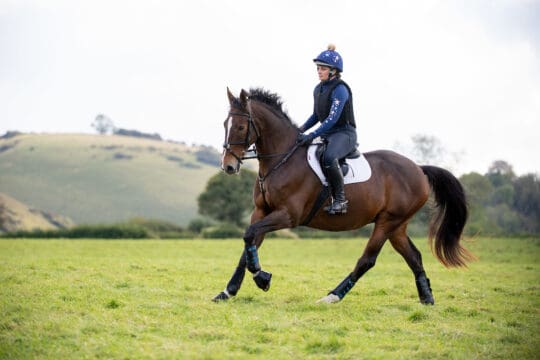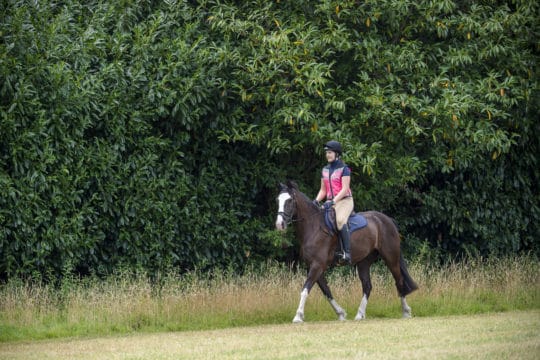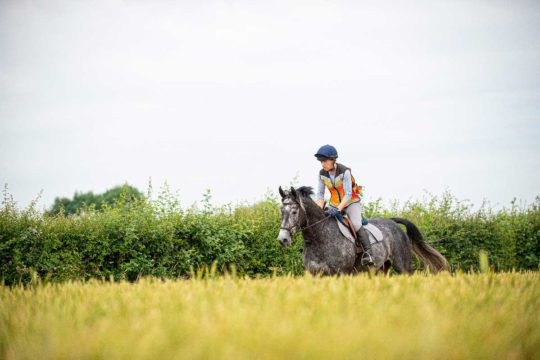Take your horse to purpose-built racehorse gallops and boost your confidence, develop impeccable timing and improve fitness with event rider, Coral Keen
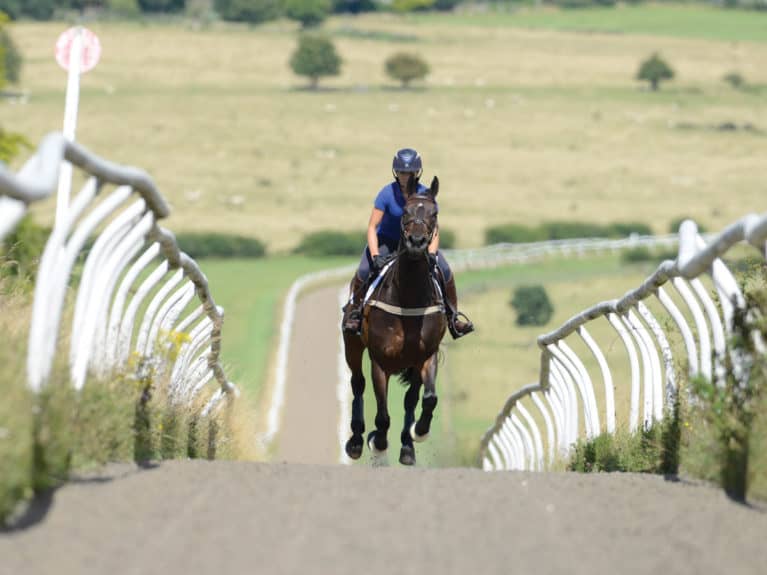
Work at the gallops can help you and your horse build confidence. The long lines of a gallop track pretty much eliminate the need for steering and allow you to concentrate on keeping him straight and forward, and establish a secure position. Plus, by the time you’ve cantered for a mile, any thoughts about being naughty will have evaporated from your horse’s mind.
Rider position
Going to the gallops not only builds your horse’s fitness, it can be a real test of rider fitness and strength, too. To adopt a galloping position, your stirrups need to be short enough for you to be able to stand up and off your horse’s back, with your hands low and on his neck. Your feet need to be well-placed in your stirrups so your heels can lower and stretch down. You can use your horse’s neck and his martingale or breastplate strap for balance.
Solo or in pairs?
Whether you use the gallops on your own or with a friend depends somewhat on your horse’s personality. If he’s a bit unsure or lacks confidence galloping, it can really help to ride him alongside a more experienced horse. Also, some horses have a natural gallop, while others need to be shown that it’s okay to move on a bit. On the other hand, there are horses who get strong and competitive when galloping with others. If your horse is like this, you may want to avoid stretching out your arms or teaching him to pull and instead work at the gallops on your own.
Before you go
- Timing is everything. When working on a track, your speed can be measured and regulated through the use of a stopwatch or helper with a timer. Once you know the length of the track, you can calculate your desired speed
- A non-slip, shock-absorbing gel pad under the saddle can help it feel more secure without having to over-tighten the girth
- Protect your horse’s legs with well-fitting brushing boots and overreach boots
- A breast girth can help the saddle stay in place, as well as give you something to grab to maintain balance when you’re standing up in your stirrups
Gallop training plans
Our gallop plans are done based on a one-mile (eight furlong) circular gallop. You can adjust them for whatever facilities and distances you have available, just remember that the distance you cover at each speed is the key element.
1. Building confidence
Horse fitness level: Moderately fit
Gallop length: One circuit of the track
Gallop speed: Go at your own pace
It’s important to start out steadily. Trot to the gallop, gradually warming up your horse’s body and settling his brain. As you trot along, remember to change your diagonal often – for example, changing it every 20 strides will help to make sure you work both sides of his body evenly. This is essential to help him avoid injury.
Are you worried about being able to hold a galloping horse? Read our advice here.
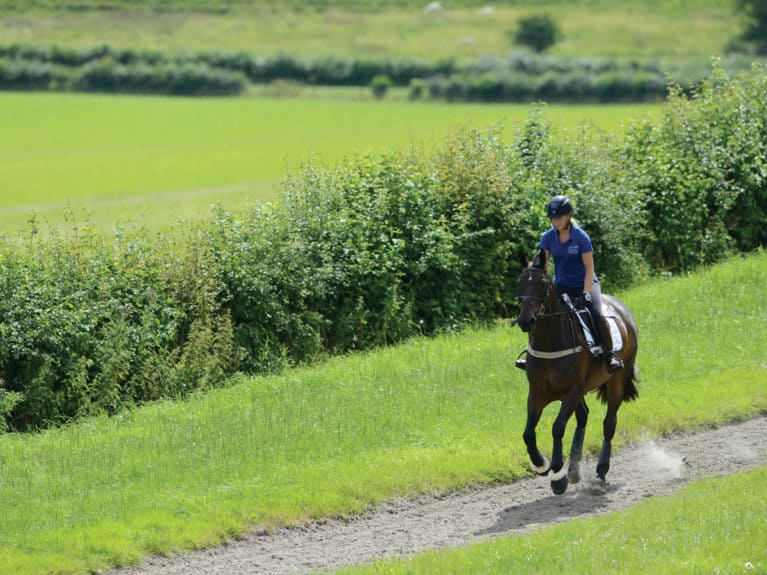
2. Develop impeccable timing
Horse fitness level: Moderately fit
Gallop length: One circular lap
Gallop speed: BE90 cross-country speed (450 metres per minute/3.34 minutes per mile)
When you watch top riders complete the Badminton or Burghley cross-country courses bang on the optimum time, you have to marvel at how they judge pace over a demanding course. But you can develop your own ability to judge your speed by using a watch and a set distance at the gallops.
At British Eventing BE90 level, the speed for the cross-country is 450 metres per minute (mpm). This means that the cross-country course will be measured and an optimum time calculated based on that speed. And while you may be travelling faster than 450mpm at certain points on the course – for example, on a long, straight stretch – you may be going slower at other points, such as on the approach to water or a combination fence. The only way to learn to judge your speed is to think about and regulate what travelling at each speed feels like. You can improve your ability to gauge your speed using a set distance, it just takes a little maths.
The maths
BE90 XC speed = 450 metres per minute
1 mile track = 3 minutes 34 seconds at 450 metres per minute
Once you get a feel of what 450 metres per minute feels like, you can vary your speed around the track. Imagine slowing for a combination, travelling on a straight stretch, then balancing for the water, and still try to achieve your optimum time of 3.34 minutes.
Case Study – developing your ability to judge speed
Jill Holt and Yocasta, stable name Tess, a seven-year-old grey mare
Jill Holt specialises in finding, producing and matching horses with Riding Club level riders. In 2017, she’s aiming her seven-year-old mare, Tess, at the Mitsubishi Motors Cup at BE90 level. Galloping at the right speed has been an important part of Tess’s development. Jill explains: “Tess is quite forward thinking and can be sensitive in her mouth, so I’ve been working towards a compromise where I have enough influence to balance and jump the fences well, while still allowing her the freedom to gallop out on the cross-country course.
“We spend a lot of time hacking in a slightly condensed cross-country canter, probably around 400 metres per minute. This helps build her strength and fitness, while instilling a bit of discipline and control – just because we’re cantering out on a hack, it doesn’t mean we are having a hoolie! Then when we get out on the cross-country course, I just let the handbrake off a little and we’re at the right speed for BE90.”
3. Improving fitness with interval training
Horse fitness level: Competition fit
Gallop length: Two eight-minute canters, two-minute walk break in-between
Gallop speed: 400 metres per minute/ 4 minutes per mile
Completing a one-mile circuit in four minutes means you are travelling in a steady, in-hand canter. This speed is only slightly faster than a working canter – use your watch to help judge your speed.
After warming up, pick up canter and cruise around the circuit. Once you’ve gone around once, walk for two minutes. This will help your horse’s heart rate recover, but not so much that you have to warm-up again. Pick up canter in the other direction and cruise around at the same pace. Concentrate on your position, staying in good balance, up and out of the saddle.
Case study
Coral Keen and four-star event horse, Wellshead Fare Opposition
“You simply can’t beat natural, grass terrain for your early conditioning and canter work with horses,” explains Coral. “I’m really lucky to have access to Salisbury Plain to do most of the basic fitness work that my horses need to get started in their eventing careers. “However, for my horses competing at British Eventing Novice level and above, I sometimes use a local, purpose-built racehorse gallop track to put the finishing touches on their fitness.”
4. Improving fitness with uphill gallops
Horse fitness level: Competition fit
Gallop length: 400m uphill stretch
Gallop speed: Start off at your competition speed (BE90 450 metres per minute, BE100 475 metres per minute)
Hill climbs on gallops are an intense workout for your horse and should only be added towards the end of your progressive fittening program. Working up a slope really makes horses breathe deeply and use their whole bodies.
Once you’ve reached the top, walk back down. Keep an eye on your horse’s rate of recovery, as this will help you judge how challenging he found the work and highlight any areas you need to adjust in his fitness programme.
Top Tip – It should feel like your horse is taking you and has a desire to go forward. If you’re kicking or urging him on, you’ve asked for too much and need to review his fitness.
Supplements
Your horse will get hot and sweaty when cantering and galloping, so you may wish to consider adding electrolytes to his feed to help replace the salts lost through sweat.
Rate of recovery
Cantering, galloping and hill work will rapidly increase your horse’s heart and respiratory rate. Depending on factors such as age, fitness and overall health, his resting heart rate will be 28–44 beats per minute. While cantering and galloping, it can range from 120–200 beats per minute. The rate of recovery is the length of time it takes for his heart rate to return to his normal resting rate. The fitter your horse is, the quicker he will return to his resting heart rate.
You can take your horse’s heart rate by placing your hand under his jaw or just behind his shoulder at the girth and feeling for a pulse. Alternatively, you can count his rate of respiration (how many breaths he takes per minute) by watching his sides as they rise and fall. Each rise and fall counts as one breath. Normal respiration rate at rest ranges from 8–16 breaths per minute.
Aftercare
Before you go out on the gallops, make sure everything is ready for when you get back so that you can get your horse cool and washed off as quickly as possible. Fill your water buckets and place them in the shade, and make sure any ice or cooling boots you use are prepared, too.
Your horse has worked hard and had fun with you on the gallops, and it’s important for his long-term health and wellbeing to establish a consistent after-care routine. While you can personalise your routine, it should go something like this…
- Cool-down
- Wash off
- Check legs
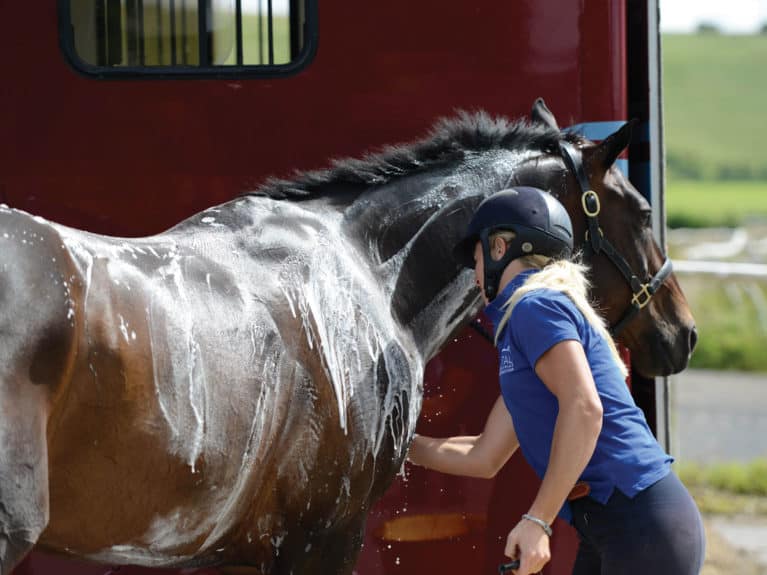
When you finish your fast work, walk your horse for at least 10 minutes. That’s a lot longer than you might think, so use a watch to time it. This will help his muscles remove lactic acid that’s built up, and allow his heart and respiration rate to return to normal. Once you’re back at your lorry or trailer, untack and offer your horse a sip of water. Then it’s time for big, sloshy sponges of cool water all over his body. You can use a muscle brace or specially designed shampoo if you wish. Sweat needs to be scrubbed off areas where tack and boots have touched him, as well as his head, belly and between his legs. The water works to cool him as well as clean off sweat and grime. Start high up, then squeeze the sponge as you go and let the water flow over his whole body. Use the time to check him over for any obvious cuts, grazes or lumps, too.
A final rinse will remove all the shampoo, then use a sweat scraper to remove the excess water. This is really important because radiated heat from his body can quickly heat up the water, stopping the essential cooling effect. If it’s a cool day, pop a thin rug on him to prevent a chill.
Leg check and ice
It’s important to pay special attention to his legs once the cooling process is complete. Look for signs of injury, scratches or rubs from boots. I like to use ice bags in ice boots on front legs, with a layer of J-cloth inside to protect the skin from ice burns. The boots stay on for 15 minutes before being swapped onto the back legs. This gives me plenty of time to get the tack cleaned and put away, and everything ready to travel home.




